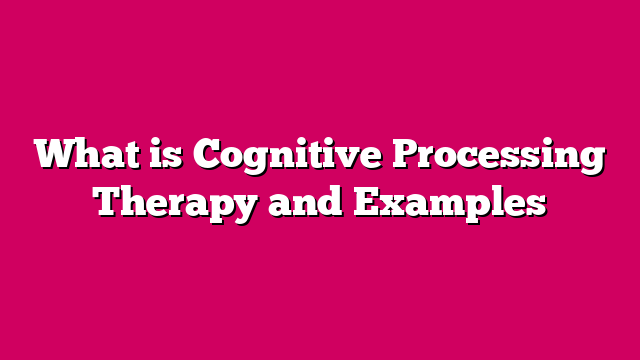Have your progress notes written for you automatically
Cognitive processing therapy (CPT) is a therapeutic approach commonly used to treat PTSD and trauma. CPT is a type of CBT specifically formulated to treat trauma related to violence, disasters and acute traumatic events. In using CPT, the therapist is helps to facilitate an interaction in which the client learns to become aware of the feelings that come up when talking about the traumatic event. Psychoeducation is a significant tenet in this therapy approach as it helps to bring context to situations to understand deeper impact and awareness of ones own experiences. CPT helps individuals challenge their negative thoughts and learn how to transform those thoughts into opportunities for growth (Bohus, et al., 2020).
How Does CPT work:
CPT is a short term therapeutic approach that lasts on average 12 sessions. The therapist uses traditional CBT techniques intertwined throughout CPT and facilitates individuals to share their experiences around their trauma, specifically their feelings related to self-image and negative views of self. The therapist evaluates symptoms of PTSD and other mood disorders such as anxiety and depression and works with the individual to rewrite their story to create new meaning of the traumatic event.
CPT can be done in individual session and family/group settings and are usually an hour long. The philosophy behind CPT is that most traumatic responses and symptoms arise from a discrepancy between self image and identity before and after the trauma. When identity is challenged, it can trigger a variety of symptoms which we often classify under PTSD and other diagnoses. CPT works to align beliefs around identity pre and post traumatic event and externalizes the event from a core belief about oneself (Weinberg, 2020).
Why CPT is used:
CPT is a great modality to help individuals feel safe in the world and in their bodies and reframe their identity so the traumatic event isn’t a mental barrier for future success. Many people who experience trauma have lasting beliefs and form memories of the negative experience and in an attempt to keep themselves safe, can use avoidance to keep themselves safe. However with avoidance, we’re not always discerning what needs to be avoided and often experience the world from a fear-based lens. CPT helps to challenge these formative beliefs by processing them in different ways to make a different meaning, one which is not fear or shame based (Lewis, et al., 2020).
What does CPT treat:
CPT can treat a variety of mental health issues. Since CPT is a type of CBT, many may begin therapy with CBT and continue their therapy journey with a CPT approach. Those who have experienced trauma often benefit from CPT and that includes survivors of domestic violence, combat and abuse. Those who seek CPT usually have a formal PTSD diagnosis and may be used in conjunction with other approaches for those who also have substance abuse issues or suicidal ideation tendencies. CPT helps to treat specific trauma symptoms including:
- Shame
- Depression
- Anxiety
- Poor impulse control
- Flat affect
- Significant mood fluctuations
- Fear
- Avoidance
- Anger
CPT Treatment Approach
CPT, like many other therapy approaches, has structured phases of treatment. Each phase has a specific focus. The phases include education, understanding their emotions, challenging newly formed beliefs and recreating new beliefs.
Phase 1
In the first phase, focused on education, individuals learn about their diagnosis of PTSD, their symptoms and other mood disorders which may be related to their trauma. The individual learns a lot about what their actions and behaviors are driven by so the individual can learn about their subconscious thoughts that may not be benefitting their long term goals. This phase also focuses on leaning about other symptoms to understand the impact on the whole mind and body to better formulate a treatment plan.
Phase 2
During phase two, which focuses on understanding their feelings and the relationship between their thoughts and feelings, the individual revisits the traumatic experience. In this phase, the goal is to think about what your beliefs are having experienced this event and how that belief may be impacting other parts of your life. The therapist and individual work together to call out the newly formed beliefs as a result of the trauma to prepare for later phases which focus on challenging these beliefs. This phase focuses primarily on the impact of this trauma on your life.
Phase 3
During phase three, which focuses on processing these beliefs identified in phase two, the therapist and individual work together to challenge these beliefs. Sometimes this includes writing prompts and learning more about how trauma and PTSD rewires the brain to learn how to rewire thought patterns so they are less limiting. This phase includes elements of education again in the context of the specific trauma the individual experienced to learn ways of thinking differently. The therapist may challenge you to look for evidence which supports or negates your belief to show you what may be safe, even if it does not feel safe at the moment. Trauma is complex in that the experience of it is more than mental, it is also emotional and physical, and these techniques are often encouraged after sessions in homework.
Phase 4
In the last phase, which focuses on recreating these old beliefs into newer, healthier and informed beliefs, the focus is on normalizing the experiences and emotions. In doing this, the therapist removes the stigma and shame around ones own identity to make sense of how and why trauma impacts us the way it does and how these techniques can help us move forward. There is more education in this phase as individuals learn how to navigate the world knowing their experiences and feelings are real and also not allowing the limiting beliefs to be a barrier in their life by giving them the confidence and knowledge on how to manage their emotions better.
In this phase, the focus is on improving the belief one may have about themself and their identity. CPT helps to improve ones self esteem and self confidence by learning new skills. It gives them more power as a result of the heightened confidence. After a traumatic event, many may doubt their abilities of handing their feelings, however CPT gives a restored sense of autonomy and self determination. CPT also improves a feeling of safety and trust in themselves and the world around them with greater self determination and skills. Ultimately, their relationships improve as they are more self aware and can better speak up for themselves and navigate challenging situations in ways which doesn’t disturb their sense of safety (Bisson and Olff, 2021).
Example of CPT
CPT may be used for many who are survivors of domestic violence. For example, Elizabeth, who developed PTSD after an abusive relationship, may often blame herself for the abuse and form beliefs about herself and her self worth. Elizabeth often tried to manage the problems in her relationship herself and thought if she did more, the abuse would stop. She often felt like it was her responsibility to manage her partner’s emotions and when she couldn’t control them, she felt a great deal of failure. This can trigger deep feelings of shame and guilt and she may be avoidant of intimacy in the future.
CPT can help her by educating her on common symptoms of trauma and understanding what her emotions are telling her. Elizabeth was likely experiencing guilt from her own potential history of people-pleasing to be accepted, and that theme was common in her relationship. Elizabeth can learn about this and begin to verbalize her new beliefs about herself and formulate a healthier self-concept. She can learn that it isn’t her job to manage someone else’s emotions and she is worthy of the kind of approach she offers. Sometimes the challenge is learning to identify the feelings and right words to describe what we experience, and the CPT phases includes support around this.
Elizabeth and her therapist can identify the points in which she may feel differently about herself after the trauma—things she may not have felt prior to the trauma. Elizabeth may learn that our minds will choose safety as a way to protect itself, however not all situations are unsafe, and CPT here can help her discern where she needs to protect herself and where her protective mechanisms are just holding her back. When she begins to externalize the trauma and no longer blames herself, she may can then form new beliefs about her experience and her identity, leading to post traumatic growth. Elizabeth can carry these techniques with her in the future to help her differentiate between actual threats and what may be a trigger but not a true threat to safety.
CPT is a very powerful approach to help many survivors of trauma. As scary as it can be to begin trauma therapy, the benefits are profound. Together you and your therapist can come up with a plan to help you feel safe in your body, and over time you will gain your confidence and strength back.
References
Bisson, J. I., & Olff, M. (2021). Prevention and treatment of PTSD: the current evidence base. European Journal of Psychotraumatology, 12(1), 1824381.
Bohus, M., Kleindienst, N., Hahn, C., Müller-Engelmann, M., Ludäscher, P., Steil, R., … & Priebe, K. (2020). Dialectical behavior therapy for posttraumatic stress disorder (DBT-PTSD) compared with cognitive processing therapy (CPT) in complex presentations of PTSD in women survivors of childhood abuse: a randomized clinical trial. JAMA psychiatry, 77(12), 1235-1245.
Lewis, C., Roberts, N. P., Andrew, M., Starling, E., & Bisson, J. I. (2020). Psychological therapies for post-traumatic stress disorder in adults: Systematic review and meta-analysis. European journal of psychotraumatology, 11(1), 1729633.
Reuman, L., & Davison, E. H. (2022). Delivered as described: a successful case of Cognitive Processing Therapy with an older woman veteran with PTSD. Cognitive and behavioral practice, 29(4), 914-923.
Weinberg, H. (2020). Online group psychotherapy: Challenges and possibilities during COVID-19—A practice review. Group dynamics: Theory, research, and practice, 24(3), 201.











